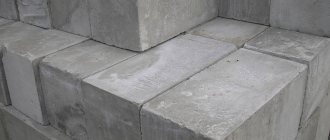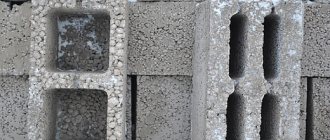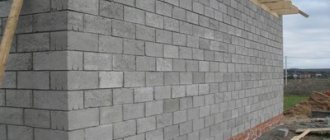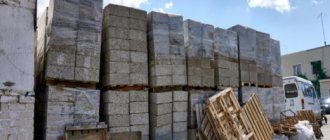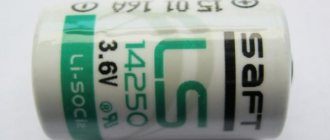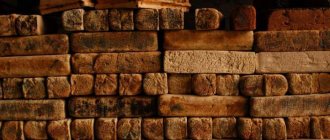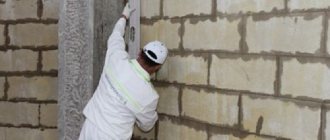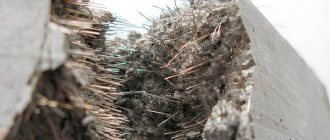Beton-House.com
Website about concrete: construction, characteristics, design. We combine the experience of professionals and private craftsmen in one place
Finished construction
Expanded clay concrete is a common material among developers, the scope of which is extremely wide. They build houses, fences, outbuildings and even foundations from it.
In this article we will talk about this in more detail and try to make sure that the use of expanded clay concrete is really relevant. We will also get acquainted with the material itself and analyze its basic properties, because they largely determine the use of the products.
- General classification
- Wall masonry
What is expanded clay concrete
Before understanding what expanded clay concrete is used for, let’s briefly consider its composition and basic set of qualities.
Material characteristics
Expanded clay concrete is made from a mixture of cement, sand, water and filler. The last one, most often, is expanded clay.
More details about the composition:
- Also, the latter can be replaced with algoporite, shungizite and some other similar materials.
- The composition often contains chemical components with which manufacturers are able to influence the final properties of products. These include, for example, saponified tree resin; it improves the physical qualities of the finished product.
- But to increase the binding capacity of the mixture, lingnosulfanate is added.
- The plasticity of the solution is increased by introducing a plasticizer into it.
Plasticizer
- The proportions of raw materials are an important point in production, because the final qualities of the material depend on the ratio.
- For example, the more cement in the composition, the stronger and heavier the block will be.
- The filler fraction also affects not only strength and weight, but also thermal efficiency.
Table 1. Material characteristics.
| Thermal efficiency directly depends on its density and can range from 0.14 to 0.5 W*/mS. That is, as the density increases, the thermal conductivity coefficient also increases. In general, we can say that the material under consideration is very competitive in this regard. If we compare it with other representatives of lightweight concrete, it occupies an average position. |
| The number of freezing and thawing cycles that the material can withstand can reach 300. Frost resistance depends on other indicators, such as strength, specific gravity. |
| The indicator can range from 400 to 2000 kg/m3. It determines the area of use more than others. We'll talk about this in more detail below. |
| Strength grades correspond to density values. The minimum is M2.0, the maximum can reach M20 or more. The load-bearing capacity of expanded clay concrete can be quite high, which is regulated by GOST. |
| The service life of expanded clay concrete blocks has not yet been established in practice. This is justified by the short existence of products on the building materials market. Manufacturers confidently declare that their products can last up to 300 years. |
| The material may be exposed to high temperatures for a certain period of time. It is fire resistant. |
| We have already talked about the composition, so we can confidently declare environmental friendliness. |
| Capable of absorbing moisture in an amount of about 14%. The indicator is relatively small, but the block still needs protection. Otherwise, it will be destroyed by slow negative influence. |
| A significant advantage of expanded clay concrete blocks is their lack of tendency to shrink. First of all, this means that finishing can begin almost immediately after the completion of the main construction work. |
| The material is quite inexpensive. The average market price is about 3,200 rubles per m3. |
Have you decided to build a cottage from expanded clay concrete blocks or another building? Your decision is correct. As you can see, the material has all the qualities necessary for the construction of a residential building. The structure, if all technologies are followed, will turn out not only durable, strong, but also warm.
Advantages and disadvantages
Do you know what strengths and weaknesses the material is endowed with? Let's figure it out. Let's start with the positive qualities.
Advantages of expanded clay concrete:
- High thermal efficiency of the material. You can build a truly warm structure from expanded clay concrete blocks. Expanded clay concrete is used to insulate buildings and individual structures, and below we will talk about this in more detail.
- Strength indicators allow the material to be used in various fields of construction. Even FBS is made from it. A basement made of expanded clay concrete blocks is a popular design.
- Environmental friendliness and fire resistance are no less significant advantages.
- Low- and medium-density material has a relatively low weight, which significantly helps reduce the load on the base.
- Frost resistance, as already mentioned, can reach 300 cycles. This is an enviable value for many competitors.
- Products, as a rule, are distinguished by considerable dimensions, which reduces the time of work.
- The low cost makes the material accessible to a wide range of developers.
- A significant advantage is the possibility of do-it-yourself production. The technology is not complicated, so almost anyone can try themselves as a manufacturer.
- The same applies to installation technology. The use of expanded clay concrete blocks as the main material in the construction of walls is widespread, and many future owners of buildings carry out the work themselves.
- Resistant to fungus and mold.
- The prevalence of the material and the variety of areas of use should also be considered advantages, and in this review we will be fully convinced of this. After all, the material is used not only in the form of products; expanded clay concrete in liquid form is also no less popular.
- Shrinkage is not inherent to the material.
- When fixing objects to an expanded clay concrete wall, almost any hardware can be used; this distinguishes the material, for example, from representatives of cellular concrete. In case of using the latter, it is necessary to purchase special fasteners.
Some benefits
Flaws:
- Expanded clay concrete blocks are not so easy to handle. The abrasiveness of the material does not allow it to be cut evenly without the use of specialized power tools.
- Hygroscopicity forces the developer to necessarily protect the wall from moisture.
- Fragility requires care during transportation and use.
- The prevalence of handicraft production increases the risk of purchasing low-quality products. When purchasing, be sure to check the quality certificate for expanded clay concrete.
Advantages of using expanded clay concrete
- Thermal insulation. Due to its high thermal insulation qualities, expanded clay concrete is successfully used in regions with low temperatures. It retains heat perfectly and can be used at any temperature, be it warm or cold;
- Economical. Expanded clay concrete is used very economically. To perform the same construction work, it requires half as much as conventional concrete. There is less shrinkage, the final weight of the product is reduced by 2-3 times. Expanded clay concrete is easy to install and increases the laying speed by 4-5 times;
- Microclimate. Expanded clay concrete does not rot, does not rust, does not burn, does not require special care conditions and at the same time retains all the beneficial properties of brick and wood. Expanded clay concrete “breathes” and maintains the microclimate of the room well.
Related articles:
| Insulation of screed with expanded clay | Modern building materials, their pros and cons | Lightweight concrete | Winter concrete |
Types of material and scope of application
Expanded clay concrete has a very broad classification. The division is based on certain factors that determine the scope of application.
General classification
Since we are talking about the use of expanded clay concrete in construction, it will be relevant to first consider the classification, which is the main one in this regard.
- Is your goal a cottage made of expanded clay concrete blocks or a small house? Give preference to products called structural and thermal insulation. Their density is quite sufficient for the construction of such buildings, while the ability to retain heat is at a relatively high level.
- But if you are interested in heat or sound insulation, thermal insulating expanded clay concrete is what you need. Its thermal efficiency has been significantly increased, which will make it possible to fully implement such plans.
- Cottages made of expanded clay concrete with a height of 3 floors or more should be erected using structural products. Their load-bearing capacity is increased, which cannot be said about thermal efficiency. Their use involves additional costs for insulating the building.
Construction material
The photo below shows the correspondence between the density and thermal conductivity of materials of different densities, and also presents a gallery dedicated to the construction of some structures made of expanded clay concrete.
What are the requirements for the above materials?In accordance with GOST:
- Thermal insulating concrete must have a specific gravity not exceeding 500 kg/m3. The thermal conductivity coefficient should be no more than 0.14, which applies to products in a dry state. But the frost resistance grade for this type of material is not standardized.
- Structural and thermal insulation products cannot have a volumetric weight of less than 500 kg/m3, a strength grade of less than B1, or a frost resistance grade of less than 25.
- The most durable expanded clay concrete (structural) must have a strength grade of at least B12.5, and a specific gravity of no more than 2000 kg/m3.
Types of products
The material in question is produced in the form of a considerable number of products. Let's look at them using a table.
Table 2. Product types.
| Name of block, product | Brief description, area of use |
| Used in the construction of walls. |
| When installing partitions |
| Specialized blocks with holes for communication wiring. A chimney made of expanded clay concrete blocks is one of the most common options for using these products. |
| Large material with standard dimensions. |
| They can be used when filling a reinforced concrete frame, when constructing a partition, as well as when installing the outer part of walls. |
| They are usually reinforced. These are monolithic or hollow products. Characterized by high strength indicators. |
Blocks can also be:
- Facial. They do not need finishing. There can be two or one facing sides.
Facial
- Ordinary, serving for the main masonry and requiring subsequent cladding.
Private
- Hollow. They are less dense and heavy, but their thermal efficiency is increased.
Hollow
- Full-bodied. They are durable and heavy. They can even be used in the construction of external walls of structures.
The surface structure determined the following division.
Blocks can be:
- Chipped;
Stabbed
On a note! Such products are called besser. A fence made of expanded clay concrete blocks of this type is very common. It has an attractive appearance, and the cost of construction is relatively budget-friendly.
Fence example
- Polished;
- Smooth;
- Grooved.
Note! The material may differ from each other and the geometry of the products. It determines in the future the thickness of the seam during laying and, as a result, the number of cold bridges. That is why, when building a residential building, you should not try to save money when purchasing products in this regard.
It is better to buy a block that is more expensive, but with almost ideal geometry and get a good result. But if you decide, for example, to build a cellar from expanded clay concrete blocks, then products with chips and a slight deviation from the linear parameters can be used.
Overlapping device
One of the main structural elements of a house is the ceiling. Various materials are used for its construction. For individual construction, various types of concrete and wood are most often used. One of the best options is considered to be a floor made of expanded clay concrete.
Thanks to its advantages, the overall load on the foundation and walls is reduced. The only drawback is that expanded clay concrete has limited strength, which, however, is quite enough for the construction of a residential building. An expanded clay concrete floor can be made in three ways: from ready-made slabs and by creating a monolithic or prefabricated monolithic floor.
Types of floors
- Lightweight slab flooring is preferable due to the fact that the speed of construction work increases. The disadvantage is the high cost of purchasing, delivering material and installation work using a truck crane.
- A monolithic ceiling will be somewhat cheaper, since it can be produced independently. However, construction work will take a lot of physical effort and time. Before pouring expanded clay concrete, it is necessary to build formwork, the creation of which will require additional material. After that, a reinforced frame is made, which is filled with expanded clay concrete. To create a frame, you need reinforcement and a curved metal corner.
- Flooring using the prefabricated monolithic method combines all the advantages of the first two methods. By increasing the speed of construction work, it becomes possible to save money. With this method, ready-made hollow expanded clay concrete blocks and beams are used, which will occupy the main volume and play the role of formwork. They are filled with expanded clay concrete on top and generally form a single structure. This ceiling is considered the most preferable option when building a house.
Proportions of raw materials for the manufacture of mixtures of various types and areas of use
In order to produce material with different average densities and different purposes, it is necessary to maintain certain proportions. Let's take a closer look.
To fill expanded clay concrete floors, the solution must be prepared in compliance with the following proportions:
- One part cement;
- Three parts sand;
- Four parts of expanded clay.
For screed
In this case, the brand of solution will be M100. If we express this ratio in kilograms, it turns out that for 25 kg of expanded clay it is necessary to use 30 kg of sand-cement mixture.
Note! The method of filling the floor may be different. It distinguishes between semi-dry, dry and wet screed. We looked at the proportions for the last option.
The proportions for the structural material are as follows:
- 1.5 parts sand;
- One part cement;
- One part of expanded clay.
In order to make lightweight material, you must use the following proportions (for making 1m3):
- 250 kg of cement;
- 130 liters of water;
- 720 kg of expanded clay.
Sand can be added, or you can do without it.
On a note! If you want to get a denser material, use expanded clay of a finer fraction.
Application of expanded clay concrete
The main direction in the use of expanded clay concrete is the construction of walls. Expanded clay concrete walls can withstand compressive loads of up to 7 MPa, and the density of the material is about 1000 kg per cubic meter.
Expanded clay concrete is also used when constructing screeds in cases where high thermal insulation and sound insulation are required. Expanded clay concrete screed significantly reduces costs and increases the speed of drying and hardening of the material
Floor slabs are made from expanded clay concrete, using dense expanded clay concrete, which contains a high percentage of cement. The installation of reinforcement and metal lathing is recommended.
Briefly about the technology of using expanded clay concrete
Since we are talking about application, it is worth paying attention to the block laying technology.
Wall masonry
Table 3. Instructions: stages of constructing a wall from expanded clay block.
| The foundation must be waterproofed. Often, ordinary roofing material laid in two layers is used for this. |
| The laying of any block begins from the highest corner. The layer thickness there will be minimal. Next, the blocks are placed in the remaining corners and a construction cord is pulled between them. It will be a good guide. If the wall is too long, it is worth installing intermediate blocks outside the corners. |
| It is recommended to use a solution. After the above steps, the row is laid completely. |
| After laying the first row, it is necessary to carry out reinforcement (as when laying every third or fourth row). Often a special mesh or reinforcement is used. |
| If the gap does not correspond to the dimensions of the block, it must be trimmed. In this case, the thickness of the seam must also be taken into account. |
| They are laid by analogy with the seams offset by 20-25%. |
| A mallet and level will help keep it level. Using a hammer, you can adjust the position of the products. |
| Finally, it is recommended to install a reinforcing belt. It will not only increase the strength of the entire structure, but also increase earthquake resistance. |
Application of monolithic material
Monolithic expanded clay concrete can be used for:
- Construction of monolithic structures;
- Insulation;
- Soundproofing;
- Screed and in many other cases.
Roof insulation
We will consider a use case using the example of building walls using formwork.
- The latter can be removable or non-removable.
- The second option often involves the use of polystyrene foam together with reinforcement elements that hold the structure.
- First, the formwork is assembled; as a rule, no difficulties arise.
- Once it is ready, you can pour the mixture.
House made of monolithic material
As you can see, everything is extremely simple.
How is the floor poured?
Let's look at this use case as well:
- Let's assume that our old floor is wooden on joists.
- The old coating must be removed.
- As a result, we get a floor made of compacted soil.
- The level is determined using a level (predominantly laser).
- The next step will be marking and installing a sand cushion.
- Next, you need to install waterproofing.
- Next, beacons are installed, in accordance with which the screed will be made.
- Finally, the solution is evenly distributed, starting from the corners.
- In order to stretch the screed, you need to use the rule.
The video in this article: “Blind area made of expanded clay concrete” will demonstrate the stages of another option for using the material when constructing a blind area to protect the foundation.
Types of expanded clay concrete
Today, expanded clay concrete grades M100, M200, M300 are most often used, but sometimes higher density concrete is also used. There are three main brands of expanded clay concrete, which are classified according to the density of expanded clay granules: dense, sandless and painted.
It is sandless expanded clay concrete that has gained high popularity in low-rise construction. This class includes gravel, crushed stone and cement. It is used for pouring floors, constructing walls and ceilings.
Painted expanded clay concrete is much less common, despite its high quality. Depending on the functionality, three subtypes of painted expanded clay concrete can be distinguished:
- Constructive. It is used in engineering structures, for example, bridges or industrial buildings;
- Thermal insulation. Used as an additional layer to increase thermal insulation;
- Thermal insulation and structural. It is used in the production of wall blocks and panels due to its increased density.
Dense expanded clay concrete combines the properties of the two listed above: painted and sandless. Dense expanded clay concrete contains a lot of cement, and this increases its cost. It is rarely used in construction work, mainly when installing walls with the prospect of high loads.
Some options for exterior wall decoration made of expanded clay block: photo gallery
The most popular options are:
- Ventilated facade. After installing the frame, it is necessary to install the finishing decorative layer. It can be: clinker panels, siding, fiber cement panels, blockhouse and many other materials.
Ventilated façade
- Wet facade. The following can be used as a decorative layer: bark beetle plaster; smalted plaster; composition with Shuba texture and others.
Plastered house with combined cladding
- Painting of expanded clay concrete blocks can also be carried out. With preliminary preparation, the surface can be obtained almost ideally.
Paint for expanded clay concrete, facade
- To prevent the need for cladding the house, you can use the same expanded clay concrete products, but with a cladding side.
Block with cladding
- Facing with ceramic brick, silicate, hyper-pressed.
Wall insulated and lined with brick
